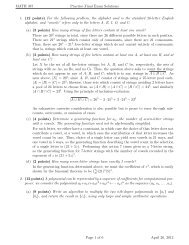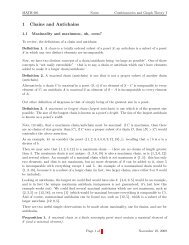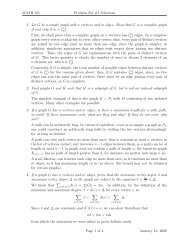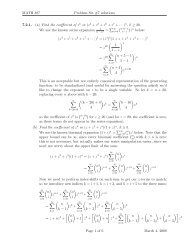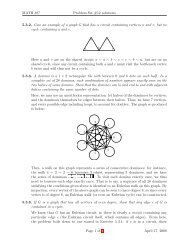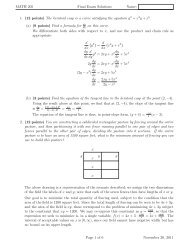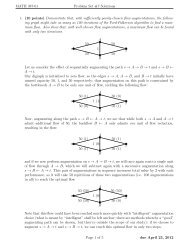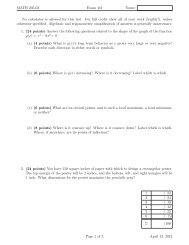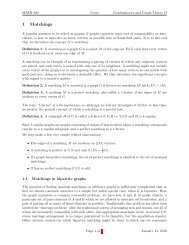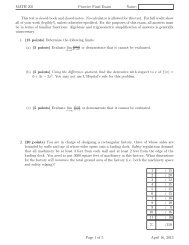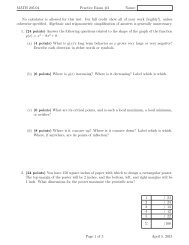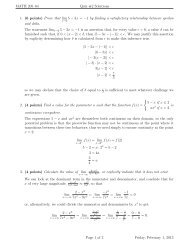MATH 190â75 Quiz #4 Solutions 1. (3 points) Find the solution of the ...
MATH 190â75 Quiz #4 Solutions 1. (3 points) Find the solution of the ...
MATH 190â75 Quiz #4 Solutions 1. (3 points) Find the solution of the ...
You also want an ePaper? Increase the reach of your titles
YUMPU automatically turns print PDFs into web optimized ePapers that Google loves.
<strong>MATH</strong> 190–75<br />
<strong>Quiz</strong> <strong>#4</strong> <strong>Solutions</strong><br />
Here we are provided with <strong>the</strong> model, and simply asked when <strong>the</strong> modeled quantity is equal to<br />
20 ◦ ; in o<strong>the</strong>r words, we are asked for which value <strong>of</strong> t it is true that T (t) = 20. Plugging this<br />
into <strong>the</strong> known formula for T (t):<br />
65 − 75e −0.1t = 20<br />
−75e −0.1t = −45<br />
e −0.1t = −45<br />
−75 = 3 5<br />
−0.1t = ln 3 5<br />
t = ln 3 5<br />
−0.1<br />
As a point <strong>of</strong> interest, and for context, <strong>the</strong> above value <strong>of</strong> t is approximately 5.1, so specifically<br />
it will take slightly more than 5 minutes for <strong>the</strong> samples to become biologically active.<br />
This contextualization <strong>of</strong> your result, however, cannot be reasonably accomplished without a<br />
calculator.<br />
5. (3 <strong>points</strong>) <strong>Find</strong> <strong>the</strong> reference number and terminal point for t = 7π 3 .<br />
Writing <strong>the</strong> coefficient <strong>of</strong> π as a mixed number, we see that t = ( 2 3) 1 π. Since <strong>the</strong> nearest<br />
multiple <strong>of</strong> 2 to 2 1 is 2 itself, we get a reference number <strong>of</strong> ˆt = ( 2 1 − 2) π = π . This terminal<br />
3 3 3<br />
point, since it is between 0 and π , is in <strong>the</strong> first quadrant, so its coordinates will be positive. The<br />
2<br />
specific coordinates associated ( with this reference number we know (from our set <strong>of</strong> significant<br />
1<br />
reference numbers) to be , √ )<br />
3<br />
.<br />
2 2<br />
6. (3 <strong>points</strong>) <strong>Find</strong> <strong>the</strong> reference number and terminal point for t = −41π .<br />
4<br />
Writing <strong>the</strong> coefficient <strong>of</strong> π as a mixed number, we see that t = ( −10 4) 1 π. Since <strong>the</strong> nearest<br />
multiple <strong>of</strong> 2 to −10 1 is −10, we get a reference number <strong>of</strong> ˆt = ( −10 1 − (−10)) π = −π.<br />
This<br />
4 4 4<br />
terminal point, since it is between − π and 0, is in <strong>the</strong> fourth quadrant, so its x-coordinate<br />
2<br />
will be positive and its y-coordinate negative. The specific coordinates associated ( √2<br />
with)<br />
this<br />
reference number we know (from our set <strong>of</strong> significant reference numbers) to be .<br />
, −√ 2<br />
2 2<br />
Anyone who believes exponential growth can go on forever in a finite world is ei<strong>the</strong>r<br />
a madman or an economist.<br />
—Kenneth Boulding<br />
Page 2 <strong>of</strong> 2 Thursday, February 25, 2010




